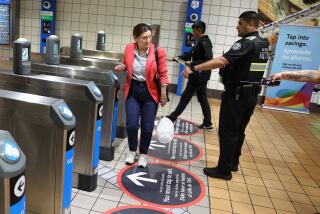Persuading 1 Worker at a Time to Cease Solo Car Commutes
At the beginning of this year, the management of 25 Glendale companies conducted a survey that showed that their employees got to work in the following way:
Seventy-seven percent drove alone, 14% came in car pools, 5% walked or bicycled, 2% took the bus, and fewer than 2% rode motorcycles or commuter vans.
Those percentages will change in the years ahead. The 77% will drop and all the others will rise, with the possible exception of motorcycles, for no one in this story is promoting the motorcycle as the best way to get to work.
The point here is that mass transit is coming to Glendale. In the vision of planners, it will come by light rail, by electric trolley and by Beeline shuttle, by van, by human power, by anything else that reduces the number of cars it takes to fill the city’s buildings with workers.
More realistically, though, it will come one worker at a time as each, under some inducement, gives up the treasured symbol of independence and personal ease.
The job of management is to find the right inducement for each employee. This work has no resemblance to the heavy industry and high technology of transportation systems. It’s being done by handshake and eye contact, over coffee in employee lounges. It’s a variant of grass-roots politics in the corporate precincts.
At Sears Roebuck on Central Avenue, the block captain is Claudia Carpenter, a young, effervescent assistant manager who was in charge of displays when higher management selected her for the additional duty of employee transportation coordinator.
Every company with 100 or more employees must appoint someone to that position. It’s required by Regulation XV, a rule promulgated by the South Coast Air Quality Management District to reduce smog by reducing car trips between 6 and 10 a.m. Under the AQMD plan, the Employee Transportation Coordinator is personally responsible for implementing the company’s Trip Reduction Plan. The plans are aimed at raising each company’s Average Vehicle Ridership to 1.5.
That’s a bundle of proper nouns whose meaning is that Carpenter must persuade 30 or so fellow employees over the next year or two to walk, bicycle, car pool or bus to work or her company will face fines.
To help her, Sears is offering a list of incentives: $15 off on a bus pass, preferential parking, a monthly drawing for a $20 gift certificate, theater discounts and an additional 10% on purchases above the company’s standard 10% employee discount.
To qualify, an employee asks Carpenter for a tally card--the same used to track weekly commission sales--and returns it with a record of days on the job without the use of a car. She issues a raffle ticket for each day and a 10% discount certificate for 10 days in any calendar month.
Carpenter can use her own ingenuity in recruiting.
First she stapled a list of the incentives to the paychecks of Sears’ 248 employees.
“It took me about an hour and half to get it done, but I thought it would be a good way to get it to them,” she said.
She also stations herself twice a week at the counter where employees pick up their paychecks to lobby in person.
Last week, she held a transportation workshop in the employee lounge. With her was Howard Quinn of Computer Transportation Services, who handed out forms for a ride-sharing database.
That day, 50 employees signed up for the database. Each will receive a computer-match list of others who live and work nearby. It is then up to them to work out ride-sharing arrangements.
Further incentives were offered by the Glendale Transportation Management Assn., a business collective formed to pursue the goals of Regulation XV.
Jeanne Olwin, executive director of the association, told the Sears staff that any of the 15,000 employees of its 25 members are eligible for free cab or rental car vouchers if they join a ride pool and miss their ride home.
Also, Olwin said, she can log on to the Computer Transportation Services database from her office computer and find a match for someone who needs a ride right away.
“We get faxed requests,” she said. “We can fax back or give them information over the phone.”
All this amounts to Sears’ first steps in a long road to transportation economy. The company began with an average vehicle ridership ratio of 1.1. It has now improved to 1.2, Carpenter said. Her goal for the coming year is 1.3.
“This is the first year when there is monetary incentives in the plan, so maybe it will be a little bit better.”
Carpenter sees progress already.
“I have one person that qualified for the extra 10% off,” Carpenter said. “By the end of this week, I’ll have two more people.
“Right now, I sold eight bus passes. Last year, we only had three people taking the bus. That’s five extra. Walking, I had five people walking. I have now seven people walking. Car pooling I have the same number as last year.”
Carpenter herself lives in Diamond Bar, so there isn’t much chance she’ll walk, bicycle or catch the shuttle. She hopes that that won’t keep her from setting a good example and also qualifying for the 10% discount.
“I’m waiting for my computer matching list to come back.”
More to Read
Sign up for Essential California
The most important California stories and recommendations in your inbox every morning.
You may occasionally receive promotional content from the Los Angeles Times.










